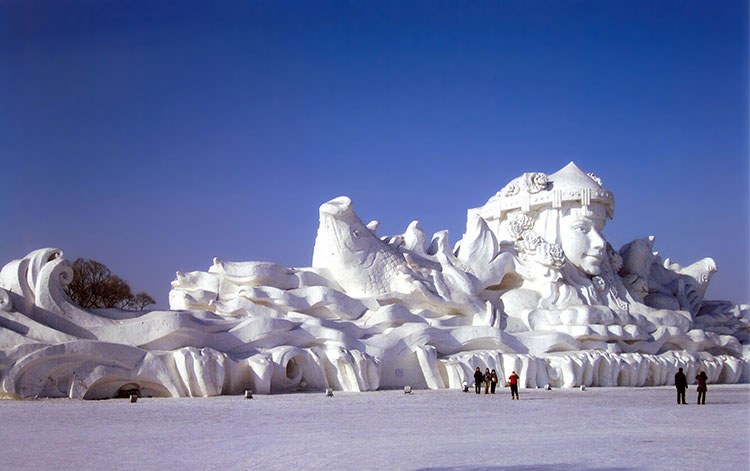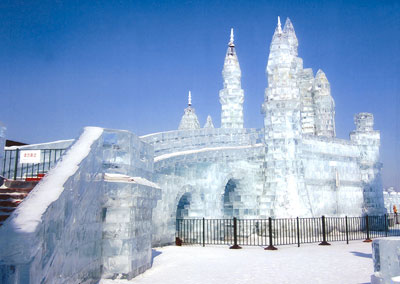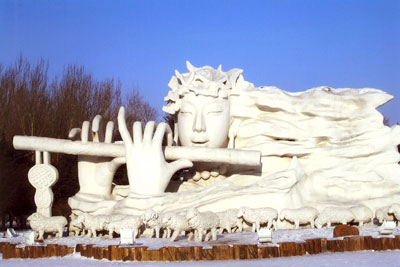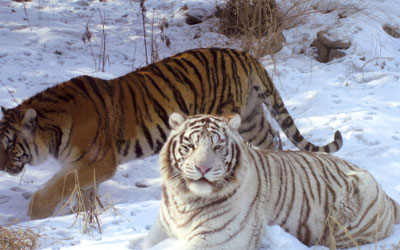Snow and ice – enjoying the winter festivals of China and Japan
This article appears on page 18 of the October 2013 issue.
Browsing online for an exciting destination for our February ’13 trip, my husband, Bernie, and I saw incredible video clips of snow and ice festivals. I found four famous ones; they are held in eastern Canada; Norway; Sapporo, Japan, and Harbin, China. We were so enchanted by the one in Harbin, it became our first-of-the-year travel destination.
Making plans
In discussing our trip plans with our travel agent, we figured out that we could visit the festivals in both Sapporo and Harbin in February, as the one in Sapporo ran Feb. 5-11 while the one in Harbin was scheduled January to February.
We flew ANA from Los Angeles to Tokyo’s Haneda International Airport, a newly refurbished airport near Tokyo’s city center. We arrived at Haneda around 5 a.m. and there was no crowd at all at Immigration. We just walked up to one of the counters, had a nice, short conversation with the officer and were in Japan in about three minutes. The Immigration officers were so polite and helpful, even helping us fill in the forms!
Our arrival at New Chitose Airport in Sapporo was a chilly one — not the people but the temperature, about 30°F. We took the JR Rapid Airport Express to Sapporo’s main station (¥1,040, or $11.95, per person), then continued by subway (Namboku Line) to Hotel Novotel (1-21 Minami Jujo Nishi 6-chome, Chuoku, Sapporo), where we spent four nights ($1,316 with buffet breakfast).
Sapporo sights
Sapporo’s layout is modern and was quite easy to negotiate. Streets run straight north-south and east-west. There is also a dense network of shopping arcades underground, so the snowy cold days don’t deter people from getting out.
Besides enjoying the Sapporo Snow Festival, we had time to visit the Sapporo Beer Museum (9-1-1 Kita 7 Johigashi, Higashi Ward; phone +81 11 748 1876), where admission is free. Located about a 10-minute taxi ride from the Sapporo JR main station, the museum has exhibits on the history of Sapporo beer.
After a brief tour, we went downstairs to enjoy three special brews available only in Hokkaido (¥500). Then we decided to investigate beer brewing in more detail by going to the brewery, itself, which is about a half hour away by train (Sapporo Beer Teien Station). Since it was Saturday, the factory was closed, but the people at the museum had called to inquire about a tour for us.
The brewery usually requires reservations, but we were able to join the scheduled group tour since there were just two of us. We did the tour, which was nicely organized, and at the end we had fresh beer from the barrel, this time at no charge. The only drawback is that the tours, both at the museum and the brewery, are conducted in Japanese — not a problem for me, as that is my native language.
The festival
Sapporo’s 64th Snow Festival was pristine and beautiful. A whole park was set up with fabulous ice structures in the center of the city.
Since Sapporo is a sister city of Munich, Germany, there was a big Maypole, presented by the city of Munich, that was also on exhibit.
One of the main attractions was a huge ski/snowboard jump as tall as a 5-story building, where young and not-so-young want-to-be champions showed off their skills.
The fabulous ice sculptures were illuminated in the evening, giving us a feeling of being in a fairyland.
On the last day of our stay in Sapporo we took a public bus to Jozankei Hot Springs, an hour’s ride. This place is famous for its abundant, mineral-rich hot springs. When we arrived, we saw steam coming from everywhere in town because it was very cold.
This place is also famous because the shrine at Jozankei makes ice lanterns during the festival, which are lit up in the evening. Most of the lanterns are made by volunteers, and if you pay a small fee they will put your name on a lantern and pray for you. They had 2,013 lanterns this year, and the effect, when all were lit, was simply magical!
Harbin
After four full days in Sapporo, we took off on Korean Air, flying to Incheon Airport near Seoul and to Beijing, China, before arriving in freezing Harbin (-5°F) at midnight. We found no taxi and no one who spoke English, and showing our hotel voucher to a policeman did no good either.
Finally, we were loaded onto the last local bus going to the city center, almost 20 miles from the airport, then we transferred to a taxi. The driver didn’t read English either, but we took off just the same. Going around the city, we miraculously arrived at Jingu Hotel (185 Zhongyanda Street, Daoli District) at around 2:30 a.m. Our standard suite cost $1,515 for six nights, including breakfast. Even at that time of night, the ice and snow sculptures we saw in town were fabulous.
Until we made up our mind to go to Harbin, we had no idea what to expect from a visit there. Checking further, we found that Harbin is a vibrant city of nearly six million people.
We took city tours with English-speaking guides to see the festival sites over two full days. On the third day, we took it easy and just walked around the city, as our hotel was located on Central Street, a pedestrian-only street, and the river was not too far away. The riverside had lots of exhibits and displays.
The two festival sites were jam-packed with people, as it was in the middle of their New Year holiday.
City sights
One of the attractions that should not be missed is Heilongjiang Siberian Tiger Park, located on the north bank of the Songhua River, northwest of Harbin. The park, covering about 350 acres, is the largest natural park for wild Siberian tigers in the world. There are over 500 purebred Siberian tigers, and about 100 of them can be seen in viewing areas.
Of course, there are more big cats: white tigers, lions, ligers (the father is a lion and the mother is a tiger), lynxes, pumas and Bengal tigers. Visitors are taken around in a bus encircled by wire mesh while the cats roam around freely in the field.
People can buy strips of meat, live chickens, live goats and even live cows, which employees set loose for the waiting tigers, but that was just too much to watch!
The city had two large snow and ice sculpture exhibit areas: the Sun Island International Snow Sculpture Art Expo and, the larger-scale one, Harbin Snow and Ice World, which took my breath away.
We visited both, once with guides and the second time on our own, taking pamphlets and our hotel brochure to show to taxi drivers. (They all had meters and the fares were fair.)
When we went with guides, we paid admission at each site, 200 to 400 yuan ($33-$65) per person. However, when we went on our own, we went up to the “Individual Visitors” ticket booth at each venue, where they asked us for our passports. When we showed them our passports, they simply said, “You go in free.”
Ice sculptures
We saw huge ice blocks encasing colorful neon light tubes. There also were sculptures of tremendous size, including palaces and cathedrals five to ten stories high that people could go up to the tops of and slide down on their behinds, on cardboard or on inner tubes. It looked like fun, but we did not do it because it was cold (about -21°F in the evening)!
We each had two layers of long silk underwear, long-sleeved shirts, sweaters, insulated windbreakers with PrimaLoft® lining, hats, earmuffs, scarves and astronaut gloves; only our faces were icy.
Apparently, there was a freak rainstorm the week before we arrived and the rainwater had frozen on the surface immediately. Since the daytime temperature never got above freezing, the surfaces of all of the city roads were simply frozen like a gigantic ice-skating rink.
It was beautiful, as the colorful sculptures were reflected on the glistening ice, but as you admired the works, you could easily slip and go down hard.
We followed the basic rules of walking on ice, but on the last day, around dusk, I slipped on stairs. Since my husband was holding my arm, he was pulled down, too. I brought back a nice, colorful leg from my knee to my ankle as a souvenir. Lucky, I did not have a fracture.
On the last day, we went to the Ice and Snow World shortly after noon. It was not at all crowded, as the 7-day Chinese New Year celebration was over and most of the working people had gone back home.
There was a snow maker in operation, and it was much easier to walk on the fresh snow than on the well-polished ice.
A nice European waltz was playing over the loudspeaker, and it was so peaceful and beautiful that we started dancing (very carefully). Some of the locals really liked our impromptu performance and they took photos and videos of us. We were dressed as a pair — red hats, red winter jackets and earmuffs — and we walked clutching each other’s arms (for dear life), so I guess we looked photogenic.
Our tour cost, including accommodations and airfare, was about $8,000 per person. We did not need guides in Japan and we used mostly public transportation there since there was no language barrier, for us.
People think that everything is expensive in Japan, but it is a matter of comparison; you pay a lot, but you get good service.
If you have any questions about this trip, email me c/o ITN.
We can say that this trip was fascinating and fabulous, a once-in-a-lifetime experience. The ice and snow festivals are growing larger every year, and the whole grandeur was just too awesome to be expressed with words.




